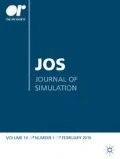Abstract
This paper is an expanded version of a presentation given at the final of the president's medal during the Operations Research Society's 50th conference held in York. The paper describes how simulation was adopted to model passenger flows in a new airport terminal and how the model is being used post opening. The paper gives an overview of some of the ways simulation has been employed at British Airways. The problem that had to be solved is described and why simulation was used. It then gives an overview of the model used to solve the problem and how it has been applied. The factors that had to be considered when carrying out the work are outlined. The paper also covers how the model was adopted for easier use and what non-simulation Operations Research approaches were used. Before looking at the lessons learnt, the paper looks at what impact the modelling has had and is still having.



Similar content being viewed by others
References
Bazargan M (2008). A simulation study to Airtran Airways super tug operations AGIFORS Airlines Operations Study Group 2008 Montreal.
Bazargan M and McGarth RN (2003). Discrete event simulation to improve aircraft availability and maintainability. Annual Reliability and Maintainability Symposium 2003 Proceedings No 63–67.
Bazargan M, Staschinski S and Li Y (2008). Airbus-380 Aircraft boarding strategies: A simulation study AGIFORS Airlines Operations Study Group 2008 Montreal.
Beck A (2004). Will we depart on time? AGIFORS Airlines Operations Study Group 2004 Washington DC.
Boyd JA, Bass EJ, Patek SDK and Lee DW (2006). Investigation of future air taxi services using discrete-event simulation. 2006 IEE Systems and Information Engineering Design Symposium No 25–30.
Crocker J and Sheng Q (2008). Is prevention better than cure? J Simulation 2: 53–60.
Fan C et al (2004). SIMAIR visualization and interactive recovery AGIFORS Airlines Operations Study Group 2004 Washington DC.
Fayez MS et al (2008). Managing airport operations using simulation. J Simulation 2, 41–52.
Herbers J (2008). Simulating flight delays in airport ground handling AGIFORS Airlines Operations Study Group 2008 Montreal.
Klein A (2004). Simulation fast forwarding and use in airlines AGIFORS Airlines Operations Study Group 2004 Washington DC.
Klempert B and Wikenhauser F (2008). Simulating the stability of flight schedules by use of a capacity model AGIFORS Airlines Operations Study Group 2008 Montreal.
Mattila V, Virtanen K and Raivio T (2003). A simulation model for aircraft maintenance in an uncertain operational environment. ESM 2003; 17th European Simulation Multiconference No 456–461.
Mitra T (2004). Using simulation to improve scheduling & performance at key airports AGIFORS Airlines Operations Study Group 2004 Washington DC.
Rijsenbrij JC and Ottjes JA (2007). New developments in airport baggage handling systems. Transpor Plan Techn 30 4: 417–430.
Robinson S (2004). Simulation: The Practice of Model Development and Use. Wiley: UK.
Salt JD (2008). The seven habits of highly defective simulation projects. J Simulation 2: 155–161.
Author information
Authors and Affiliations
Rights and permissions
About this article
Cite this article
Beck, A. Case study: modelling passenger flows in Heathrow Terminal 5. J Simulation 5, 69–76 (2011). https://doi.org/10.1057/jos.2011.4
Received:
Accepted:
Published:
Issue Date:
DOI: https://doi.org/10.1057/jos.2011.4




